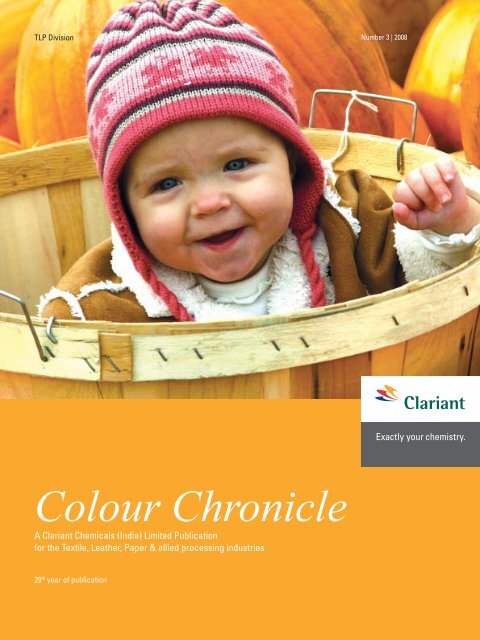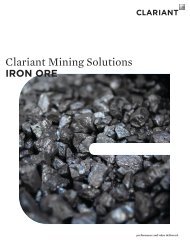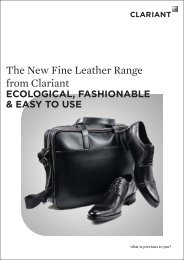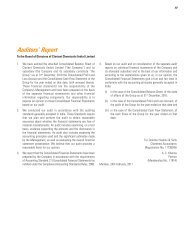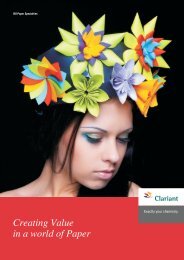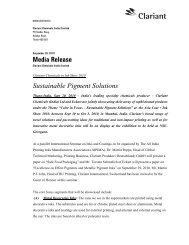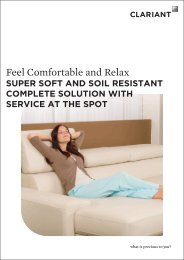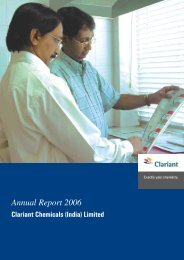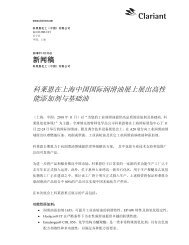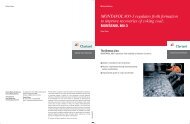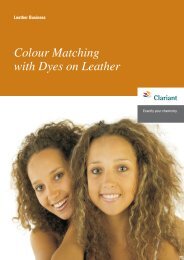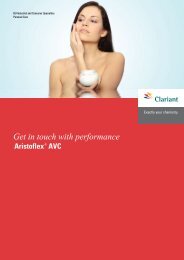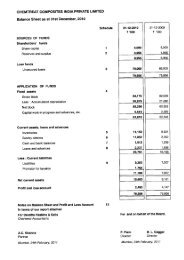Colour Chronicle - Oct 2008 - Clariant
Colour Chronicle - Oct 2008 - Clariant
Colour Chronicle - Oct 2008 - Clariant
You also want an ePaper? Increase the reach of your titles
YUMPU automatically turns print PDFs into web optimized ePapers that Google loves.
TLP Division<br />
<strong>Colour</strong> <strong>Chronicle</strong><br />
A <strong>Clariant</strong> Chemicals (India) Limited Publication<br />
for the Textile, Leather, Paper & allied processing industries<br />
29 th year of publication<br />
Number 3 | <strong>2008</strong>
colour chronicle 3 | <strong>2008</strong><br />
Contents<br />
textile 3<br />
Cotton and Acrylic Fibers Blends<br />
Dyeing of PAC/Wo and PAC/CEL blends<br />
coldblack ® : Sun Reflector – UV Protector<br />
Some facts about light fastness<br />
leather 12<br />
New NMP-free Aqualen ® Tops by <strong>Clariant</strong><br />
Tanicor ® OS-IN p<br />
paper 15<br />
Cartacoat ® RM rheology modifiers<br />
Strength from the inner core<br />
GOTS approved list 19<br />
new arrivals 20<br />
inside views 22<br />
gleanings from press 25<br />
2 colour chronicle 3 | <strong>2008</strong>
Dyeing Methods and Dye Selection for Blends of:<br />
I – One Bath Method with Modified Basic<br />
Dyes for Acrylic and Indosol SF Dyes for<br />
Cellulosics<br />
This method is only recommended for pastel and<br />
medium shades.<br />
Thiotan S liq prevents precipitation between the<br />
cationic modifi ed basic dyes and anionic Indosol SF<br />
dyes, which may occur depending on the dyes and<br />
concentrations used.<br />
Standard recipe<br />
It is essential to set the dye bath in the following<br />
order:<br />
Liquor ratio: 1/10<br />
a) 1 g/l Thiotan S liq<br />
0.5 g/l sodium acetate<br />
Run 5-10 minutes<br />
b) x % Modified Basic Dye<br />
Run 5-10 minutes<br />
c) y % Indosol SF dye<br />
6 g/l sodium sulphate anh.<br />
d) Adjust pH to 4.5 - 5 with acetic acid.<br />
Dyeing Programme<br />
Acrylic<br />
II – Two Bath Method with Modified<br />
Basic Dyes / Drimaren CL Dyes<br />
For better brilliance and high wet fastness properties<br />
we can dye this blend in two baths with modifi ed<br />
basic dyes and Drimaren CL dyes.<br />
It is preferred to give wash with hot wash at 80°C<br />
for 10 minutes before dyeing cycle starts.<br />
Dyeing the acrylic component with modifi ed<br />
basic dyes dyes in the 1st bath<br />
Dyebath Composition<br />
x % modified basic dye<br />
0.3 g/l Ekaline F.IN liq<br />
6-8 g/l sodium sulphate anh.<br />
0.5 g/l sodium acetate<br />
3.5-0.5 % Retargal ANI based on<br />
acrylic component weight<br />
– Higher % for lighter<br />
depth<br />
pH = 4.5 acetic acid 80%<br />
Dyeing Programme<br />
Cotton<br />
Cotton and Acrylic Fibers Blends<br />
textile<br />
colour chronicle 3 | <strong>2008</strong> 3
4<br />
textile<br />
colour chronicle 3 | <strong>2008</strong><br />
Over Dyeing the Cotton Component with Drimaren<br />
CL Dyes in the 2nd Bath<br />
Classic Drimaren dyeing with Thiotan S liq to<br />
avoid chances of precipitation and agglomeration<br />
of leftover cationic dyestuff and Drimaren dyes<br />
(0.5 g/l)<br />
After Treatment<br />
Rinse well<br />
Treat at 70 - 80°C for 15 mins. with:<br />
1 g/l Lyocol OU liq<br />
pH = 9 using soda ash<br />
Rinse.<br />
Special Treatment for very High Wet Fastness<br />
Properties.<br />
After treat with Optifi x F liq<br />
Same Method in Reverse Order<br />
Although, it is economical to carry out this method<br />
in the reverse order, i.e. fi rst dyeing the viscose<br />
component with Drimaren dyes and then the PAC<br />
with modifi ed basic dyes, dyed cotton component<br />
is more heavily stained by the basic dyes while the<br />
PAC is being over dyed (mordant effect), than when<br />
dyeing according to the conventional method. For<br />
this reason, the reverse method can only be carried<br />
out with specially selected basic dyes.
As a rule, PAC/Wo blends are dyed<br />
as yarn. Special attention has to<br />
be paid to the shrinkage. The ratio<br />
of the fi ber components, the self of<br />
wool, the felting tendency of wool<br />
and the glass transition point of the<br />
acrylic fi ber are also important factors.<br />
The most interesting process is the<br />
possibility of dyeing this blend in one bath.<br />
It has to be borne in mind that the wool is<br />
dyed in an acid medium with anionic dyes<br />
whereas PAC is dyed with cationic dyes in<br />
same medium.<br />
There are two problems to be solved:<br />
The prevention of precipitations between<br />
the two dye classes and the prevention of<br />
dye losses.<br />
While many non-ionic surfactants are<br />
soluble to prevent the precipitations, it is<br />
diffi cult to achieve both aims. The cationic<br />
dye, stains the wool at low temperature and<br />
migrates on reaching the glass transition<br />
point to the acrylic fi ber. The degree<br />
of staining of the wool at the end of the<br />
dyeing depends on:<br />
Saturation of the acrylic fi ber.<br />
Depth of the shade.<br />
Cationic dyes used.<br />
Use of glauber’s salt.<br />
Use of a suitable dispersant.<br />
The wool dyes hardly stain the PAC<br />
fi ber but are greatly hindered in exhausting<br />
onto the wool by unsuitable dispersants.<br />
Thiotan S liq achieves both aims; it<br />
disperses well and does not prevent build<br />
up on wool dyes.<br />
The Optilan MF dyes are particularly<br />
suitable because they dye the wool at<br />
textile<br />
Dyeing of PAC/Wo and<br />
PAC/CEL blends<br />
the isoelectric point and level without<br />
electrolyte at a pH which corresponds<br />
exactly to the recommendation for dyeing<br />
acrylic fi bers.<br />
Since the wool absorbs part of the acid,<br />
the pH of the bath may increase and lead to<br />
the following problems:<br />
Attack on the cationic dyes by<br />
hydrolysis.<br />
Increase in the staining of the wool<br />
dyes by hydrolysis.<br />
Only mediocre reproducibility of the<br />
shade on the wool component.<br />
For this reason, we recommend adding<br />
a little acid before the end of dyeing at<br />
98°C or 105°C to promote exhaustion of<br />
the basic dyes on the acrylic fi ber and the<br />
wool dyes on the wool. With deep shades,<br />
it is advisable to wash off with Ekaline<br />
F.IN liq to improve the end use fastness<br />
properties.<br />
PAC fi bers and Cotton or Viscose<br />
complete each other quite well in their<br />
physiological behavior (PAC: warm, non<br />
felting; CEL: good moisture absorption,<br />
no electrostatic charging). Due to their<br />
non-felting behavior, PAC/Co blends are<br />
becoming increasingly popular in the<br />
market. For these blends an HT dyeing<br />
is not necessary and very brilliant shades<br />
can be produced. One bath or one bath two<br />
stage processes are possible with results<br />
which meet the fastness requirements for<br />
domestic laundering.<br />
Again the dye classes used (cotton<br />
dyes – anionic; PAC dyes – cationic dyes)<br />
pose certain problems but <strong>Clariant</strong> offers<br />
solutions with various alternatives:<br />
colour chronicle 3 | <strong>2008</strong><br />
5
textile<br />
6 colour chronicle 3 | <strong>2008</strong><br />
Shade Dyes Dyeing Process<br />
Pale modified basic One Bath<br />
dyes/Indosol SF<br />
Pale-medium modified basic One Bath<br />
dyes/Indosol SF<br />
Dark modified basic One Bath/<br />
dyes/Indosol SF two stage<br />
Brilliant modified basic<br />
dyes/Drimaren K Two Bath<br />
Dark & Drimaren XN/ Two Bath<br />
Brilliant modified basic dyes<br />
(fixation with<br />
Optifix F liq)<br />
The shade and fastness properties are determined<br />
by the selection of dyes for the CEL fi ber. The<br />
economy is determined by the process.<br />
In all one bath processes the addition of a<br />
dispersant such as Thiotan S liq paste is essential<br />
to avoid precipitations in the dye bath. At the same<br />
time Thiotan S liq improves the cellulosic fi ber<br />
reserve towards the modifi ed basic dyes.<br />
With high dye concentrations only one bath two<br />
stage process is suitable.<br />
The reserves of the PAC fi ber to Direct or Indosol<br />
dyes depend on the substantivity of the individual<br />
dye. The dyes for application should be selected<br />
carefully. Further, the reserve decreases with<br />
increasingly acid pH value. The addition of cationic<br />
retarders increases staining of the acrylic fi bers.<br />
The addition of glauber’s salt required for one bath<br />
exhaustion of the direct dyes has a retarding effect<br />
on the cationic dyes and therefore, increases the<br />
tendency to staining of the cellulosic fi ber.<br />
Dyeing is carried out at pH values between 4<br />
and 5 to exclude any hydrolysis of the cationic dyes.<br />
This may cause problems with the solubility of the<br />
direct dyes. In the one bath two stage process, special<br />
attention must be paid to the dyeing conditions<br />
which could be unfavourable for the cationic dyes.<br />
Migration of the modifi ed basic dyes is possible at<br />
98°C in the presence of salt at a pH above 7. The pH<br />
should therefore, not rise above 6 in the second stage<br />
and the temperature not above 85°C. The presence<br />
of Thiotan S liq paste disperses any precipitations.<br />
Brilliant shades can only be obtained with<br />
reactive dyes on the CEL component. When using<br />
the Drimaren K dyes, the PAC component is dyed<br />
fi rst as usual and then the CEL component in a fresh<br />
bath with Drimaren K dyes by one of the usual<br />
processes. These processes have very little effect on<br />
the shade of the PAC dyeing. Finally, the goods are<br />
rinsed and washed off at 80°C with Lyocol OU liq<br />
and Ladipur RSK liq.<br />
When dyeing the opposite way round, i.e., when<br />
the reactive dyes are applied fi rst, they act as mordant<br />
for the cationic modifi ed basic dyes because of their<br />
sulpho groups. Severe staining and poorer fastness<br />
properties on the CEL component are the result. Hot<br />
dyeing reactive (Drimaren X/XN) cannot be used for<br />
cross dyeing because of the high amount of salt and<br />
alkali required. They lead to migration and change<br />
of shade of the basic dye on the PAC component. In<br />
reversed processes where CEL component is dyed<br />
fi rst, most basic dyes also show a mordant effect on<br />
the CEL component dyed with Drimaren X dyes.<br />
<strong>Clariant</strong> has developed a process which is based<br />
on the principle of blocking the sulpho groups of the<br />
reactive dyes by a treatment with Optifi x F liq. After<br />
this treatment the PAC component is cross dyed<br />
with modifi ed basic dyes.<br />
An intermediate fi xation treatment with Optifi x<br />
F liq achieves two things:<br />
a) The mordanting effect is almost completely<br />
prevented, because the strongly anionic reactive<br />
dyes on the CEL fi ber surface are neutralized<br />
by the cationic Optifi x F liq, so that afterwards<br />
when PAC component is dyed, the basic dye can<br />
no longer be adsorbed on the CEL component.<br />
b) Treatment with Optifi x F liq also binds a portion<br />
of the unfi xed reactive dye, thus obtaining better<br />
yield and even at this point, nearly attaining the<br />
desired wet fastness properties.<br />
The over dyeing of the PAC component also acts<br />
as a soaping bath so that the laborious conventional<br />
soaping treatment to remove the unfi xed and<br />
hydrolyzed reactive dye becomes unnecessary.<br />
The reserve procedure also permits shading of<br />
the PAC component, which as a rule involves fewer<br />
problems than shading the CEL component.
coldblack ® : Sun Reflector –<br />
Dark colours heat up stronger when exposed to<br />
direct sunlight compared to light colours. Many<br />
textiles worn in the summer time or exposed to the<br />
sun offer poor protection from damaging UV rays.<br />
In order to prevent this from occuring, we have<br />
come up with cold black process.<br />
coldblack ® UV Protector<br />
combines two functions in one special<br />
fi nishing technology for textiles:<br />
– Sun Refl ector<br />
– UV Protector<br />
Effective Heat Management<br />
Light coloured textiles refl ect both visible and<br />
invisible rays of sunlight, meaning both heat and<br />
light.<br />
Dark coloured textiles absorb both types of rays<br />
and therefore, absorb heat.<br />
coldblack ® reduces this absorption of heat rays<br />
particularly in the case of darker colours and in<br />
all types of textiles.<br />
The result is tangibly better heat management.<br />
Without coldblack ®<br />
Dark textiles without coldblack ® absorb heat.<br />
With coldblack ®<br />
Dark textiles with coldblack ® refl ect heat.<br />
Reliable Protection from UV Rays<br />
Many textiles worn in the summer time or exposed<br />
to the sun offer poor protection from damaging UV<br />
rays.<br />
The coldblack ® technology guarantees a minimum<br />
UPF 30+ protection when applied to any textile** in<br />
any colour without affecting the look or feel of the<br />
product.<br />
The UV protection factor (UPF) gives an indication<br />
of how much longer someone using coldblack ®<br />
textiles can remain in the sun without incurring any<br />
skin damage. The calculations were based on the socalled<br />
self-protection time of the skin, which varies<br />
according to individual skin type.<br />
** Important: The UPF value can vary depending on structure,<br />
thickness and material. It relates to closed textile surfaces.<br />
For this reason, the UPF factor needs to be determined<br />
on the different textiles. From a minimum of UPF 30+,<br />
coldblack ® conformity is guaranteed.<br />
Skin Types with varying Degrees of Self-protection<br />
Skin Description Sunburn risk in high<br />
type summer midday after<br />
I Pale skin with freckles<br />
blonde or red hair<br />
approx. 5 to 10 minutes<br />
II Pale skin and blonde hair<br />
blue or green eyes<br />
approx. 10 to 20 minutes<br />
III Medium skin dark hair<br />
and brown eyes<br />
approx. 20 to 30 minutes<br />
IV Naturally dark skin black<br />
or dark hair brown eyes<br />
approx. 40 minutes<br />
coldblack ® - Practical examples<br />
Skin Protection with coldblack ® textiles<br />
type (UPF 30+)UPF x self-protection of skin<br />
I 150 to 300 minutes = 2.5 h to 5 h until skin reddens<br />
II 300 to 600 minutes = 5 h to 10 h until skin reddens<br />
III 600 to 900 minutes = 10 h to 15 h until skin reddens<br />
IV 1200 minutes = 20 h until skin reddens<br />
textile<br />
colour chronicle 3 | <strong>2008</strong> 7
8<br />
textile<br />
colour chronicle 3 | <strong>2008</strong><br />
coldblack ® -Reliable Protection from UV Rays<br />
Without coldblack ®<br />
Light coloured textiles without Coldblack ® allow<br />
UV-rays to penetrate<br />
With coldblack ®<br />
Light coloured textiles with coldblack ® signifi cantly<br />
reduce UV-rays from penetration<br />
Examples for UV Protection measures and their<br />
UV Protection factors<br />
UV protection UV protection<br />
measures<br />
Shade under a parasol<br />
factor<br />
without special UV protection appox. 5<br />
Shade under a tree approx. 10<br />
Light cotton clothing<br />
Sun cream with correct<br />
approx. 10<br />
application<br />
Thick cotton clothing<br />
0 to 30<br />
without coldblack ® approx. 20+<br />
Textiles with coldblack ® minimum 30+<br />
Many textiles equipped with coldblack ® demonstrate a<br />
UV protection factor of over UPF 50.<br />
coldblack ® - Advantages<br />
Optimal Protection from Heating-up due to<br />
Sunlight<br />
Because textiles fi nished with<br />
coldblack ® heatup less in all<br />
colours compared with material<br />
without a coldblack ® fi nish.<br />
Textiles stay Cool to the Touch<br />
When applied to clothing, this<br />
means that the wearer perspires<br />
less, feels better and is capable of<br />
greater performance.<br />
Reliable protection from UV rays (minimum<br />
UPF 30+)<br />
– Protection from UV-A rays and<br />
UV-B rays.<br />
– UV-A rays accelerate the aging<br />
of the skin.<br />
– UV-B rays cause a pigment<br />
change that result in long term browning. Without<br />
effective UPF protection (Ultraviolet Protection<br />
Factor), aggressive oxygen molecules are released<br />
which cause sunburn or which can lead to the<br />
formation of melanoma.<br />
“bluesign ® Approved”<br />
Components<br />
The coldblack ®<br />
fi nishing only contains<br />
“bluesign approved”<br />
components.<br />
“bluesign approved” components are as low as<br />
possible in harmful substances, making them<br />
benign to mankind and the environment and<br />
encouraging the economical and ecological use<br />
of resources in the production process.<br />
Coldblack ® – Advantages at a Glance<br />
Less sweat.<br />
Increased concentration.<br />
Higher performance.<br />
Greater comfort.<br />
Increased endurance.<br />
Minimum UPF 30+.<br />
No adverse effect on looks, feel or breathability.<br />
Function lasts through numerous washing and<br />
cleaning processes.<br />
Finish comprises “bluesign approved”<br />
components.<br />
Following are the wide range of applications and<br />
lifestyle categories, which provide added comfort<br />
due to coldblack ® :<br />
outdoor<br />
bike<br />
sportswear<br />
workwear<br />
uniforms<br />
merchandising<br />
tents<br />
umbrellas
In Love with Fashion<br />
Dyestuff range: Foron ® S-WF<br />
Today’s high consumer quality<br />
awareness in an ever so competitive<br />
textile environment, need special products<br />
to meet the ever growing demands.<br />
Especially in terms of trendy wash and<br />
wear, easy care and soft touch products<br />
(with the increasing use of micro-fi ber<br />
articles), highest levels of colour fastness<br />
are required. With the Foron ® S-WF<br />
dyestuffs, an evolution of the Foron ® Stype<br />
disperse dyes (pioneered by us in<br />
the 1950’s when still operating under the<br />
former Sandoz name), we do not only<br />
meet these requirements, but today can<br />
offer a conclusive range of dyestuffs,<br />
which are able to cover the full scope<br />
of fashion shades. Foron ® S-WF with its<br />
market leading colour fastness levels and<br />
highest sublimation fastness enhances<br />
today’s textile products in the apparel,<br />
workwear and sportswear segments, whilst<br />
giving textile producers state-of-theart<br />
process and environmental security.<br />
<strong>Clariant</strong>’s especially developed products<br />
and processes for colourfast Polyester<br />
include:<br />
A complete range of colourfast<br />
dyestuffs; Foron ® SWF gives excellent<br />
wet-fastness levels, with highest<br />
sublimation fastness.<br />
The necessary auxiliaries needed for<br />
reproducible and reliable dyeing e.g.<br />
Dispersing agent Lyocol ® RDN liquid<br />
and Acid buffer Opticid ® PSD liquid.<br />
Recommended pre-treatment, dyeing<br />
and after-treatment processes in<br />
exhaust and continuous dyeing.<br />
Dyestuff criteria for high wet-fastness<br />
polyester and blends:<br />
High operational reliability<br />
Very good dispersion stability<br />
High to very high sublimation<br />
fastnesses for yarns and tops<br />
High stability in further processing<br />
steps (e.g. reactive dyeing)<br />
Processing requirements (e.g. for postsetting)<br />
Full scope of elements to cover fashion<br />
shades<br />
Foron ® Golden Yellow S-WF<br />
0.08% 0.27% 0.80% 2.40%<br />
Foron ® Red S-WF<br />
0.19% 0.60% 1.80% 5.40%<br />
Foron ® Rubine S-WF<br />
0.40% 0.95% 2.84% 8.52%<br />
Foron ® Brilliant Yellow S-WF<br />
0.14% 0.44% 1.32% 4.00%<br />
Foron ® Scarlet S-WF<br />
0.09% 0.31% 0.92% 2.76%<br />
Properties<br />
The Foron ® S-WF dyes are elements with<br />
the following special properties:<br />
Highest sublimation fastness, therefore,<br />
ideal range for yarn dyeing as well as<br />
for continuous applications (Thermosol<br />
dyeing) and for printing<br />
Highest wet fastness level after postsetting<br />
(mode of action: increase of<br />
water solubility in alkaline fastness<br />
testing liquors, but keeping the<br />
chromophore intact)<br />
Easy clearable (high alkaline solubility,<br />
therefore, no reductive clearing<br />
necessary for articles with little to<br />
moderate staining like e.g. PES/CEL<br />
blends; reductive clearing is, however,<br />
necessary for articles with heavy<br />
staining like blends with Spandex ® +,<br />
Lycra ® +, XLA ® +etc.)<br />
Foron ® Violet S-WF<br />
textile<br />
0.09% 0.32% 0.95% 2.85%<br />
Foron ® Cyanine S-WF<br />
0.13% 0.32% 0.97% 2.90%<br />
Foron ® Blue S-WF<br />
0.10% 0.21% 0.63% 1.90%<br />
Foron ® Navy S-WF<br />
0.09% 0.35% 1.06% 3.18%<br />
Foron ® Black S-WF<br />
0.12% 0.39% 1.18% 3.54%<br />
Scope of Application<br />
The Foron ® S-WF dyes are recommended<br />
for the following applications:<br />
Exhaust dyeing of PES/CEL (SWIFT<br />
exhaust process), PES/XLA, PES/<br />
CEL/XLA ® + and PES articles that are<br />
being post-set (knitwear) and/or that<br />
require above average wet fastness<br />
(sportswear)<br />
Continuous dyeing of PES/CEL<br />
(SWIFT continue process), PES/CEL/<br />
XLA ® + and PES articles<br />
Printing of PES, PES/XLA ® + and PES/<br />
PUE articles<br />
® + XLA is an elastic polyethylene fiber and is a<br />
trade mark of DOW Chemicals.<br />
colour chronicle 3 | <strong>2008</strong><br />
9
10<br />
title textile<br />
colour chronicle 3 | <strong>2008</strong><br />
Some Facts about Light<br />
Fastness<br />
Textile Dyes and Pigments used in the industry<br />
vary to a great extent in terms of their<br />
resistance to light sources and this phenomenon<br />
is called as ‘Light-fastness of Textiles’.<br />
Sunlight materials electromagnetic radiations<br />
of several wavelengths. Visible range of spectrum<br />
(400 - 700 nm), ultraviolet (300 - 400 nm) and infra<br />
red (700 - 1400 nm) become the main constituents<br />
which reach to the earth’s surface.<br />
<strong>Colour</strong>ed materials like Textile, Leather and<br />
Paper when subjected to the photons generated from<br />
the sunlight have tendency to destroy the colouring<br />
constituents of dyes and pigments. Further prolonged<br />
exposure may even cause destruction to the substrate<br />
itself. Partial destruction of the colouring material<br />
in dyes and pigment is known as fading. The other<br />
detrimental effect could be change of tone or change<br />
of brilliance of the colour.<br />
A consumer when buys an apparel is attracted<br />
to the colours and if this colour is altering / fading<br />
during usage or laundering, the consumer gets<br />
frustrated, so it is our responsibility to safeguard and<br />
guide the processor about the fading behavior of a<br />
dye/pigment applied on the substrate.<br />
There are many factors infl uencing the light<br />
fastness behavior.<br />
Substrate and their diffusion properties.<br />
Substrate preparation.<br />
Chemical nature of the fi ber.<br />
Method of the application.<br />
Delusterants in the substrate.<br />
Finishing chemicals applied.<br />
Usage of the article.<br />
Dye-fi xers used.<br />
Choice of colours and their combination.<br />
Perspiration and exposure to light.<br />
Prolonged exposure to light.<br />
Oxidative or reductive nature of dye fading<br />
reaction.<br />
Unfortunately, the tag labels on articles do give<br />
wash instruction but the guidance and sustainability<br />
of the article to multiple exposures to light are not<br />
so popular. There are hardly any indicators to guide<br />
the consumer regarding the resistance of the article<br />
towards sunlight fading.<br />
Uncontrollable Factors<br />
Content of UV amount in the sunlight: As more<br />
is the UV component more photons of their light<br />
and more will be the effect on colour with respect<br />
to fading.<br />
The intensity of temperature from the sunlight<br />
falling on the article.<br />
Relative Humidty<br />
Higher the humidity, higher could be fading.<br />
This factor has impact on the wet-light fastness<br />
and hence fading in varying humid environments<br />
come into the picture.<br />
Atmospheric contaminations.<br />
Amount and quality of perspiration also play a<br />
crucial role in deciding the amount of fading.<br />
Laundering pattern.<br />
Repeated laundering and exposure to sunlight<br />
or a single exposure to sunlight also affects the<br />
degree of fading.<br />
Some Guidelines<br />
Higher the depth, better the light fastness.<br />
Only right choice of colours can help in getting<br />
better light fastness and any corrective actions<br />
would fail to improve the light fastness.<br />
Right choice of textile chemicals to ensure that<br />
no detrimental effect of them on the light fastness<br />
of dyed articles occur.<br />
When use of more than one colour is made in<br />
making a shade, the fi nal light fastness of the<br />
article will be based on the lowest light fastness<br />
constituent of the dye in the recipe. This is more<br />
important when we want to ensure on-tone<br />
behavior of fading after exposure to light (one<br />
component fading to smaller extent will give a<br />
further ugly appearance to the shade than one<br />
with on-tone fading).
leather<br />
New NMP-free Aqualen ® Tops<br />
State-of-the-art technology for todays’ leather<br />
fi nishing is based on aqueous products. <strong>Clariant</strong>’s<br />
efforts to reduce VOC in fi nishing products have led<br />
to a new solution within the Aqualen ® Top Coat range.<br />
Great variety of gloss levels can be reached<br />
by combining Aqualen ® Top DC-2050 (dull) and<br />
Aqualen ® Top GC-2051 (glossy). This new generation<br />
of easy to handle top coats are distinguished by a<br />
perfect balance of high performance and excellent<br />
aesthetics. Most different looks and feels can<br />
be generated using this product mix alone or in<br />
combination with other ecologically-friendly<br />
Aqualen ® /Melio ® Tops and/or the versatile Melio®<br />
WF feel additive range. This enables the fi nisher<br />
to cover a wide range of leather articles. The still<br />
widely used nitro/emulsion lacquer product can<br />
be partly replaced – a further step towards VOC<br />
reduction in leather fi nishing.<br />
Especially developed for high gloss shoe upper<br />
leathers is Aqualen ® Top GC-2030.A. Leathers<br />
top coated with Aqualen ® Top GC-2030.A are<br />
distinguished by a very natural and casein-like<br />
look and surface feel together with high wet rub<br />
properties. Additionally, Aqualen ® by <strong>Clariant</strong><br />
Top GC-2031 is<br />
suitable for shoe upper leathers and for high gloss<br />
fancy and upholstery leathers as well, where even<br />
higher physicals are requested. Both products are<br />
plateable at high temperatures and show a very good<br />
intercoat adhesion together with very good milling<br />
behavior.<br />
12 colour chronicle 3 | <strong>2008</strong><br />
For aqueous patent leather imitations <strong>Clariant</strong><br />
offers the new Aqualen ® Top LN.A. This new<br />
ecological top coat product is developed to meet<br />
highest requirements of both, gloss level and<br />
physicals. Leathers fi nished with Aqualen ® Top<br />
LN.A, an aqueous, modifi ed, aliphatic polyurethane<br />
dispersion, show beautiful brilliance and depth of<br />
gloss. The application can be done either by reverse<br />
roller coater or by spraying technology. This new<br />
and really helpful characteristic offers quite a lot of<br />
options to the fi nisher.<br />
Aqualen ® Tops:<br />
The ecological solution for<br />
perfect leather finishing
Tanicor ® OS-IN p<br />
“Low Free-Formaldehyde”<br />
Replacement Syntan<br />
Features<br />
Low in “Free-Formaldehyde” content<br />
Versatile replacement syntan suitable for<br />
all type of leather<br />
Good fullness coupled with grain<br />
tightness<br />
Uniform Dyeability<br />
Can be used for dark and pastel shades as<br />
well.<br />
Leather traded with Tanicor ® OS-IN p<br />
can pass various specifi cations of “low-freeformaldehyde”<br />
limits when tested by DIN<br />
53315.<br />
leather<br />
Tanicor ® OS-IN p can also be used with<br />
<strong>Clariant</strong>’s other “Low Free-Formaldehyde”<br />
products to produce various leather articles.<br />
For the complete list of <strong>Clariant</strong>’s “Low Free-<br />
Formaldehyde” products, please refer our<br />
product guide.<br />
Our technical service team would be happy<br />
to be at your service for the development of<br />
“Low Free-Formaldehyde” systems, with<br />
Tanicor ® OS-IN p.<br />
Suggested usage of Tanicor ® OS-IN p in<br />
retannage:<br />
1. For Upper Leathers : 6 to 10%<br />
2. For Clothing Nappa : 4 to 6%<br />
3. For Cow Bag Leather : 3 to 5%<br />
Formaldehyde as a raw material is widely<br />
used in the manufacture of leather chemicals<br />
for condensation of various monomers like<br />
phenol, naphthalene, urea, etc.<br />
colour chronicle 3 | <strong>2008</strong><br />
13
Strength from the Inner Core<br />
Dry strength solutions by <strong>Clariant</strong><br />
Growing use of Recycled Fiber<br />
large quantity of waste paper and board<br />
A is recycled, providing a relatively<br />
cheap source of cellulosic fi ber raw<br />
material for papermaking. Unfortunately,<br />
the quality of fi ber in wastepaper is<br />
deteriorating, due to increased recycling,<br />
and the dry strength of a paper sheet<br />
inevitably suffers as a consequence.<br />
Dry Strength Additives needed<br />
Dry strength additives have been available<br />
in the paper industry for many years.<br />
Natural polymers such as starch, either in<br />
its native or chemically modifi ed form, have<br />
been employed relatively successfully, due<br />
to their availability and low cost.<br />
Paper makers around the world want<br />
to raise the standards associated with dry<br />
strength, closer to the values achieved with<br />
virgin fi ber. At the same time, they work at<br />
lowering the basis weight of a paper sheet,<br />
whilst maintaining an acceptable level of<br />
strength, aiming at major cost benefi ts<br />
and reducing of the impact of high energy<br />
prices.<br />
Starch has its Drawbacks<br />
There has been a temptation to add<br />
excessively high amounts of starch<br />
because, although low in cost, the strength<br />
performance of starch is between 5 and<br />
10 times less than a synthetic dry strength<br />
polymer, on a dry basis. Starch, even in<br />
its cationized form, has a limited affi nity<br />
for paper fi bers and large quantities of<br />
solubilized material remain in the water<br />
circuits of the paper machine, where they<br />
act as nutrients for bacteria and interfere<br />
with the affi nity of other paper making<br />
additives. In the tissue industry, the rigidity<br />
of starch polymers has a negative infl uence<br />
on softness and dusting.<br />
<strong>Clariant</strong>’s Cationic Polymers Solution<br />
Achim Kohler (<strong>Clariant</strong>, Germany)<br />
remembers: “Back in 2004/2005, we<br />
identifi ed the growing problems with the<br />
fi ber quality of the waste paper. We therefore<br />
decided to address the customers’ needs<br />
for low cationic, highly concentrated and<br />
effi cient products with good absorption. In<br />
particular, the low cationic charge of the<br />
new products developed was intended to<br />
prevent the fi ber charge from fl ipping to<br />
cationic from anionic.”<br />
Newborn in the Range, Cartabond ® 0701E<br />
liquid<br />
The most recently developed product of<br />
the range, Cartabond 0701E liquid, is a<br />
dry strength additive for stock application<br />
under neutral to alkaline paper making<br />
conditions. It is suitable for all paper and<br />
board grades but especially benefi cial where<br />
recycled fi ber is the main raw material.<br />
Typical examples are brown packaging<br />
papers manufactured from old corrugated<br />
containers (OCC), tissue produced by<br />
fully bleached virgin or recycled fi bers.<br />
All strength parameters can be improved,<br />
including burst, tensile, SCT and CMT.<br />
paper<br />
Mode of Action<br />
A combination of ionic and hydrogen<br />
bonding is responsible for the superior<br />
strength. Starch relies almost entirely on<br />
hydrogen bonding for strength development<br />
but ionic bonding, which is up to fi ve times<br />
stronger, allows enhanced performance.<br />
In addition, Cartabond 0701E liquid has<br />
strong affi nity for cellulosic fi bers and<br />
is, therefore, perfectly suited to wet-end<br />
application.<br />
Ahead of the Trend, Indian Product<br />
Cartabond SR 100 liquid<br />
Cartabond SR 100 liquid is a local<br />
alternative to Cartabond 0701E liquid<br />
available in India. It is a liquid dry strength<br />
resin offering improved tensile strength,<br />
stiffness and burst factor and is specifi cally<br />
recommended for stiffness improvement in<br />
copier paper as well as coated paperboards.<br />
It can also replace starch, whilst unlike<br />
starch, Cartabond SR 100 liquid is not<br />
susceptible to microbial attack, thereby<br />
eliminating the need for preservatives as<br />
well as environmental concerns.<br />
Back in 2004, Indian papermakers were<br />
actually a bit in advance in the demand for<br />
an alternative to strarch. Cartabond SR 100<br />
liquid was developed to answer the need. As<br />
Rajinikanth Prasad (<strong>Clariant</strong>, India) recalls:<br />
“we developed a liquid form for a specifi c<br />
customer – which happened to be a clear<br />
advantage for our local customers”!<br />
colour chronicle 3 | <strong>2008</strong> 15
paper<br />
Cartacoat ® RM Rheology Modifiers<br />
16 colour chronicle 3 | <strong>2008</strong><br />
More than just Rheology Modifers<br />
P<br />
roducing coated paper and board for<br />
end-products with a high quality level<br />
needs chemicals that can really do the job.<br />
Cartacoat RM is an exclusive range of rheology<br />
modifers, which allows control of high shear and<br />
low shear viscosity and water retention to achieve<br />
superior runability and optimum coating colour<br />
rheology. Cartacoat RM products can be used for<br />
instance for blade coating or MSP applications with<br />
all kind of paper and board grades.<br />
The Cartacoat RM series combines the features<br />
expected from such products, whilst allowing<br />
substantial savings in your production costs.<br />
Optimized Chemistry<br />
The thickening mechanism of Cartacoat RM<br />
rheology modifiers, as shown in the illustration<br />
below, comprises of two steps:<br />
Expansion of macro-chains, due to high<br />
electrostatic charge repulsion<br />
Inter-molecular attraction facilitates formation<br />
of a 3-D network<br />
Carbon group<br />
Hydrophobic group<br />
“Less-is-More” effect<br />
Cartacoat RM products replace conventional<br />
synthetic rheology modifiers with lower blade<br />
pressure, allowing increased coater speed.<br />
Cartacoat RM products make it possible to<br />
increase the dry solid content of the coating<br />
colour, with a positive effect on optical and<br />
printing properties.<br />
Cartacoat RM products can replace CMC<br />
partially or totally, offering the possibility to increase<br />
the amount of PVOH or starch as an OBA<br />
carrier, in order to improve whiteness.<br />
Signifcant Benefits for your System<br />
Up to 30 % cost savings in thickener system<br />
Improved coating colours and runability<br />
- Lower dosage needed to reach the targeted<br />
Brookfield viscosity<br />
- Better high shear profile<br />
- Improved water retention at lower dosage<br />
Improved paper and print quality<br />
- Positive effect on paper gloss<br />
- Slightly improved smoothness<br />
- Other properties equal (mottling, ink<br />
absorption and surface strength)<br />
The effect of<br />
Cartacoat RM<br />
products on<br />
viscosity and shear<br />
rates can be seen<br />
on the graph at the<br />
adjacent.
Complete Range for Every Specific Need<br />
Cartacoat RM 8 liquid<br />
Cartacoat RM 8 liquid is a water retention aid for<br />
paper and board coating colour with small effect on<br />
low shear and high shear viscosity. Cartacoat RM<br />
8 liquid improves the paper properties by reducing<br />
water penetration into the base sheet. Cartacoat RM<br />
8 liquid is FDA and BfR compliant.<br />
Cartacoat RM 12 liquid<br />
Cartacoat RM 12 liquid allows good water retention<br />
and increases both low and high shear viscosity.<br />
Cartacoat RM 15 liquid<br />
Cartacoat RM 15 liquid is especially suitable in<br />
the manufacturing of coated board and packaging<br />
paper, offering a good balance between Brookfield<br />
viscosity and water retention. Cartacoat RM 15<br />
liquid is FDA and BfR compliant.<br />
Cartacoat RM 20 liquid<br />
Cartacoat RM 20 liquid shows optimal high shear<br />
properties with high Brookfield viscosity. Small<br />
dosing levels are needed. Cartacoat RM 20 liquid<br />
has low influence on high shear viscosity and low<br />
blade pressure.<br />
Dynamic Water Retention<br />
DT coater<br />
World-class Laboratory Facilities<br />
From laboratory studies to pilot coating trial<br />
to mill trial, our laboratory facilities in France<br />
offer high-end equipment and expertise.<br />
Low shear viscosity High shear viscosity Water retention Dosing levels (*)<br />
Cartacoat RM 8 ( ) 0.5 – 2.0<br />
Cartacoat RM 12 0.1 – 1.0<br />
Cartacoat RM 15 0.2 – 1.5<br />
Cartacoat RM 20 0.05 – 1.0<br />
= high influence<br />
(*) parts per 100 parts pigments as it is<br />
= medium influence = some influence = no influence<br />
ACAV<br />
ÅA-GWR<br />
paper<br />
colour chronicle 3 | <strong>2008</strong><br />
17
Result of Assessment of Dye / Processing aid for the use in EKO<br />
Sustainable Textile Standard (GOTS system)<br />
Name dye/Proc. aid Date of Approved<br />
approval Yes / No<br />
Ceranine SWPI liq 25/06/2007 Yes<br />
Diresul Antioxidant PRM liq 25/06/2007 Yes<br />
Drimaren Turquoise CL-B p 13/03/2007 Yes<br />
Sirrix 2 UD. IN liq 13/08/2007 Yes<br />
Drimaren Navy X-GN. IN 06/09/2007 Yes<br />
Drimaren Red X-6 BN p 06/09/2007 Yes<br />
Drimaren Yellow X-4RNI p 06/09/2007 Yes<br />
Leonil UH liq 06/09/2007 Yes<br />
Sirrix Antox IN liq 06/09/2007 Yes<br />
Imacol C2G.IN liq 12/10/2007 Yes<br />
Sirrix N liq c 12/10/2007 Yes<br />
Ceraperm K.IN liq 12/10/2007 Yes<br />
Stabilizer AWN.IN liq 12/10/2007 Yes<br />
Stabilizer FCB.IN liq c 12/10/2007 Yes<br />
Sirrix SB.IN liq 12/10/2007 Yes<br />
Appretan ECO liq 12/10/2007 Yes<br />
Imerol XN.IN liq 04/08/2007 Yes<br />
Rintofix Thickener CA liq 13/11/2007 Yes<br />
Revatol S.IN p 13/11/2007 Yes<br />
Sirrix N liq 13/11/2007 Yes<br />
Stabilizer SIFAM.IN liq 13/11/2007 Yes<br />
Printofix Binder 1912 PLUS 14/12/2007 Yes<br />
Printofix Binder ITL liq 14/12/2007 Yes<br />
Hostapal DTC. IN liq<br />
Formerly (Sandopan<br />
DTC. IN liq)<br />
22/01/<strong>2008</strong> Yes<br />
Global Organic Textile Standard<br />
The latest version of the Global<br />
Organic Textile Standard (GOTS)<br />
launched in June, sees some signifi cant<br />
changes for the wet processors of organic<br />
textiles. The changes note as follows:<br />
Optical brighteners are now allowed<br />
to be used, allowing all retailers to<br />
produce organic cotton products in a<br />
bright white.<br />
Quaternary ammonium compounds –<br />
which are known to improve the colour<br />
fastness of dyed goods - are prohibited<br />
except for auxilaries used during the<br />
dyeing process, provided they meet all<br />
other GOTS criteria.<br />
Heavy metals are prohibited with a<br />
specifi c exception for copper metal<br />
Name dye/Proc. aid Date of Approved<br />
approval Yes / No<br />
Imerol NLF. IN liq [ Formerly<br />
(Sandoclean NLF. IN liq) ]<br />
22/01/<strong>2008</strong> Yes<br />
Leomin PNLI liq [ Formerly<br />
(Sandosoft PNLI liq) ]<br />
22/01/<strong>2008</strong> Yes<br />
Ceralube JNF. IN liq<br />
Formerly (Sandolube<br />
JNF. IN liq)<br />
22/01/<strong>2008</strong> Yes<br />
Ceralube HD. IN liq<br />
Formerly (Sandolube<br />
HD. IN liq)<br />
22/01/<strong>2008</strong> Yes<br />
Imerol MWP liq c [ Formerly<br />
(Sandoclean MWP liq c) ]<br />
22/01/<strong>2008</strong> Yes<br />
Ladipur SN liq [ Formerly<br />
(Sandopur SN liq) ]<br />
22/01/<strong>2008</strong> Yes<br />
Optisul HSI liq<br />
Formerly (Sandozol HSI liq)<br />
22/01/<strong>2008</strong> Yes<br />
Stabilizer SIFA. IN lq 11/02/<strong>2008</strong> Yes<br />
Imerol SR liq 11/02/<strong>2008</strong> Yes<br />
Stabilizer SOF. IN liq 11/02/<strong>2008</strong> Yes<br />
Diresul Black RDT-S-IN liq<br />
Formerly (Diresul Black<br />
RDT liq)<br />
11/02/<strong>2008</strong> Yes<br />
Drimaren Blue HF-2B cdg 12/02/<strong>2008</strong> Yes<br />
Ladipur R3C. IN ip liq 12/02/<strong>2008</strong> Yes<br />
Drimaren Navy CL-R p 12/02/<strong>2008</strong> Yes<br />
Arkofil PVS p 13/03/<strong>2008</strong> Yes<br />
Arkofil S 100 p 13/03/<strong>2008</strong> Yes<br />
Ceraperm 3P PLUS liq 13/03/<strong>2008</strong> Yes<br />
complex dyes to produce blue, green<br />
and turquoise shades to a depth of 5%<br />
owf.<br />
The above clauses are to be reviewed<br />
in two years from date of adoption. If,<br />
at that time, copper complex dyes are<br />
no longer permitted this would cause a<br />
problem for dyers producing the shades<br />
mentioned and would therefore limit<br />
the shades available for the retailers of<br />
organic products. Another change of note<br />
is that acceptable levels of formaldehyde<br />
on organic textiles have been reduced<br />
from 20 mg/kg to 16 mg/kg in line with<br />
Japanese law.<br />
There is also a clause not to allow<br />
products with the following risk phrases:<br />
GOTS approved list<br />
Name dye/Proc. aid Date of Approved<br />
approval Yes / No<br />
Ceraperm AQUA liq 13/03/<strong>2008</strong> Yes<br />
Drimaren Red CL BL 13/03/<strong>2008</strong> Yes<br />
Drimaren Red CL-B p 13/03/<strong>2008</strong> Yes<br />
Drimaren Yellow CL-R p 13/03/<strong>2008</strong> Yes<br />
Ladiquest DWA liq 13/03/<strong>2008</strong> Yes<br />
Leomin SFC liq 13/03/<strong>2008</strong> Yes<br />
Printofix Navy R-B 13/03/<strong>2008</strong> Yes<br />
Printofix Violet R-B 13/03/<strong>2008</strong> Yes<br />
Printofix Black R-NG liq 13/11/2007 Yes<br />
Printofix Blue R-BN 20/03/2007 Yes<br />
Ceraperm TSLF liq 11/06/<strong>2008</strong> Yes<br />
Ceraperm 3P liq hc 11/06/<strong>2008</strong> Yes<br />
Reductor D. IN p 11/06/<strong>2008</strong> Yes<br />
Stabilizer 3Z liq 11/06/<strong>2008</strong> Yes<br />
Sirrix SAI liq c 12/06/3008 Yes<br />
Hostalux ETB. IN liq 17/06/<strong>2008</strong> Yes<br />
Leucophor BMF. IN liq 17/06/<strong>2008</strong> Yes<br />
Leucophor BMB. IN liq 17/06/<strong>2008</strong> Yes<br />
Leucophor BFB. IN liq 17/06/<strong>2008</strong> Yes<br />
Appretan PUL liq 29/07/<strong>2008</strong> Yes<br />
Ceraperm MN liq 29/07/<strong>2008</strong> Yes<br />
Mercerol QWNI. IN liq 29/07/<strong>2008</strong> Yes<br />
Mercerol RWLF liq 29/07/<strong>2008</strong> Yes<br />
Sirrix CPA liq 29//07/<strong>2008</strong> Yes<br />
Sirrix USB liq 29/07/<strong>2008</strong> Yes<br />
R50, very toxic to aquatic organisms;<br />
R51, toxic to aquatic organisms; R52,<br />
harmful to aquatic organism; R53, may<br />
cause long term adverse effects in the<br />
aquatic environment. However, GOTS<br />
states that as R51-R53 may lead to a loss<br />
in dyeing quality, the use of these will<br />
be optional until the next revision of the<br />
standard. This is a confusing situation that<br />
may leave many dyers unclear about the<br />
dyes and chemicals that can be used; it<br />
is recommended that in the certifi cation<br />
process these parameters should be<br />
controlled, documented and reported.<br />
source: www.colourclick.org;<br />
GOTS v 2.0 is available at:<br />
www.global-standard.org<br />
colour chronicle 3 | <strong>2008</strong> 19
20<br />
new arrivals<br />
Additions in Local Range Global<br />
Printofix ® Red T-B<br />
Bright Red Dispersion from<br />
Global Printofix Range<br />
Product Performance<br />
Highly concentrated pigment.<br />
Good dispersion stability even below 0°C.<br />
Very little infl uence on viscosity of<br />
synthetic thickener.<br />
High dry cleaning fastness.<br />
High thermal stability.<br />
Suitable for discharge printing.<br />
Suitable for all types of printing application<br />
i.e., aqueous, semi-aqueous and solvent<br />
base.<br />
Does not contribute in gelling of printing<br />
paste.<br />
Printofix ® Yellow T-C<br />
Lemon Yellow Dispersion from<br />
Global Printofix Range.<br />
Product Performance<br />
Bright lemon yellow shade.<br />
High pigment concentration.<br />
Very little infl uence on viscosity of<br />
synthetic thickener.<br />
High dry cleaning fastness.<br />
High thermal stability.<br />
Suitable for discharge printing.<br />
Suitable for all types of printing application<br />
i.e., aqueous, semi-aqueous and solvent<br />
base.<br />
Does not contribute in gelling of printing<br />
paste.<br />
colour chronicle 3 | <strong>2008</strong><br />
Foron ® Scarlet S-WF<br />
High wet fast disperse dye<br />
for red and scarlet shades<br />
suitable for dyeing polyester<br />
and its blends.<br />
Product Performance<br />
High wet fastness. Low staining on<br />
multifi ber even on post heat set fabric.<br />
Can be applied in exhaust, printing and<br />
continuous application.<br />
Main element for wet fast fi re shade in<br />
combination with Foron Brilliant Yellow<br />
S-WF, Foron Golden Yellow S-WF, and<br />
Foron Red S-WF.<br />
High sublimation fastness even at 210°C.<br />
Good dispersing and leveling properties.<br />
Foron ® Violet S-WF<br />
High wet fast disperse dye<br />
for violet shades suitable<br />
for dyeing polyester and its<br />
blends.<br />
Product Performance<br />
High wet fastness. Low staining on<br />
multifi ber even on post heat set fabric.<br />
Can be applied in exhaust, printing and<br />
continuous application.<br />
Main element for wet fast violet and purple<br />
shade in combination with Foron Blue<br />
S-WF and Foron Rubine S-WF.<br />
High sublimation fastness even at 210°C.<br />
Good dispersing and leveling properties.<br />
Launches<br />
Afilan ® PSE liquid<br />
Afi lan ® PSE liq. is a spin fi nish<br />
suitable for polyamide 6 and 6.6 high<br />
tenacity industrial yarns for example<br />
tyre-cord, tarpaulins, seat belts,<br />
conveyer belts etc. Afi lan PSE liq.<br />
is a proprietory blend of heat stable<br />
lubricants, emulsifi ers and antistats.<br />
Is usually applied as an aqueous<br />
solution (e.g. 15-25 %) with the<br />
usual devices.<br />
Is a very thermostable spin<br />
fi nish.<br />
Forms very low smoke and shows<br />
nearly no deposits on the godets.<br />
Runs well in drawing processes<br />
and has a good fi ber/fi ber<br />
cohesion.<br />
Owns excellent wetting and<br />
spreading properties.<br />
Afilan ® ONE liq<br />
Easy applicable fi ber fi nish<br />
and lubricant for use in fi ber<br />
manufacturing of polysulfonamide<br />
and aramide fi bers.<br />
Excellent lubricating properties.<br />
Good antistatic properties.<br />
Improves fi ber/fi ber cohesion and<br />
reduces fi ber/metal friction.<br />
Excellent wetting properties.<br />
Good thermostability.<br />
Each component of this<br />
formulation is listed in one or<br />
several parts of 21.CFR.170-199<br />
(FDA).
Foron ® Black AS-3LF<br />
New disperse black Dyestuff for high-fast<br />
applications.<br />
High light-fast and hot-light-fast black<br />
disperse dyestuff.<br />
High strength (30%<br />
stronger than Foron Black<br />
AS-LF) and build-up.<br />
Neutral shade under different light<br />
sources (D65/TL84/A).<br />
Low colour fading post exposure.<br />
Suitable for all commonly required<br />
automotive light-fastness standards.<br />
Excellent sublimation fastness upto<br />
180°C/30sec.<br />
Very good combinability with UVabsorbers<br />
(Fadex ® ).<br />
Suitable as base element for Coldblack ®<br />
applications.<br />
Foron ® Dark Blue S-WF<br />
New disperse blue dyestuff for high wetfast<br />
applications.<br />
High wet-fast dark blue disperse<br />
dyestuff.<br />
Excellent build-up.<br />
Neutral (greenish) shade .<br />
No reddish fl are under artifi cial light<br />
sources (TL84/CWF).<br />
Excellent cotton reserve.<br />
Good clearability above pH 9.<br />
Leading sublimation fastness upto<br />
210°C/30sec., (rating 4.9 GS).<br />
Eganal ® PLM liquid<br />
New dyeing assistant for exhaust dyeing<br />
of polyester and its blends with cellulosic<br />
fi bers injets and package dyeing machines<br />
under HT conditions.<br />
Improves dispersion stability of the<br />
dyes in the bath.<br />
Ensures good penetration and increased<br />
colour yield.<br />
Improves coverage of materials with<br />
different affi nity.<br />
Allows to reduce the dyeing time and/<br />
or the dyeing temperature.<br />
Improves the reservation of the<br />
cellulosic part by dyeing polyester/<br />
cellulose blends.<br />
Improves the in-out levelness in<br />
package dyeing mac hines.<br />
Is suitable for levelling and partial<br />
stripping of faulty dyeings.<br />
Does not affect the wet fastnesses and<br />
has no or minimal effect on the usual<br />
light fastness.<br />
Does not develop an unpleasant odor<br />
during dyeing or drying.<br />
Is non foaming.<br />
Arkofix ® ELF liq conc<br />
Ultra low formaldehyde containing cross<br />
linking agent for the easy care fi nishing of<br />
textiles of cellulosic fi bers and their blends<br />
with synthetic fi bers.<br />
Has a free formaldehyde content below<br />
0.1 %.<br />
Produces particularly low formaldehyde<br />
fi nishing effects. Meets the requirements<br />
of consumer labels such as Eco-Tex<br />
Standard 100 for textiles worn next to<br />
the skin (
inside views<br />
Technical Conferences during the Last<br />
A.K. Prasad interacting with customers in Kolhapur.<br />
22 colour chronicle 3 | <strong>2008</strong><br />
P. Gayatri being welcomed by Mr. A. Karmarkar at Kolhapur Meet.<br />
Technological Skills and Partnerships based on<br />
active dialogue with customers are key elements<br />
in the building of a successful relationship. Keeping<br />
this as the focus various technical conferences<br />
were held all over the country as narrated below:<br />
Surat, June 19, <strong>2008</strong><br />
At the conference, Mr. Anjani K. Prasad, Country<br />
Head of Textile, Leather & Paper Chemicals<br />
Division, <strong>Clariant</strong> Chemicals (India) Limited,<br />
emphasized that <strong>Clariant</strong> has developed cost effective<br />
processing packages for polyester dyeing, printing<br />
and fi nishing chemicals. Ecological demands are<br />
also being catered to by our experts. <strong>Clariant</strong> has<br />
also introduced innovative fi nishes like moisture<br />
management, which gives polyester a comfortable<br />
feel, while imparting a protective fi nish against<br />
bacteria and fungi. Fluorocarbons from <strong>Clariant</strong>,<br />
speciality silicones and innovative prints like gold<br />
zari were elaborated upon during the conference.<br />
With the textile and apparel industry always on the<br />
lookout for new fi nishes and aesthetic values on the<br />
fabric, chemicals from <strong>Clariant</strong>’s range enhance<br />
both the physical appearance and performance of<br />
the end–product.<br />
Mr. Jochen Schmidt, Head, Business Line<br />
Functional Effects, <strong>Clariant</strong> International Ltd.,<br />
discussed in detail about the various products<br />
which can be offered to the processors in Surat. He<br />
highlighted on the ‘Emerging Trends in Finishing<br />
with <strong>Clariant</strong>’s Technology’, consisting of silicone<br />
based products like, concentrated specialty fi nishing<br />
agents which can be easily diluted and used as inhouse<br />
formulations to a high cost advantage. Mr.<br />
Schmidt also highlighted on the Technical Textiles<br />
and stressed on the concept of Flame Retardants and<br />
Stain Management.<br />
Kolkata, June 24, <strong>2008</strong><br />
An this occasion, Mr. Anjani K. Prasad, emphasized<br />
that <strong>Clariant</strong> offers complete solutions for the<br />
processing of knits, garment washing, pigment<br />
printing and in jute related processing. He stressed<br />
on the benefi ts of Ecoswat Concept, highlighting the<br />
The Ludhiana Meet participants.
Detailed analysis in Bengaluru.<br />
Quarter<br />
use of right technology for optimization of energy,<br />
water and effl uent management. He explained the<br />
Black Magic Process, which is a bleaching concept<br />
involving process effi ciency with economy using<br />
ecological concept. He discussed in detail the<br />
garment washing process using biotechnology,<br />
wherein he enlightened the customers with the<br />
enzyme processing of the garments. He also<br />
highlighted the leaning of prossessors towards<br />
the latest trends in Technical Textiles offered by<br />
<strong>Clariant</strong>, such as ultra low formaldehyde based<br />
binders, non-PFOA concept of fl uorocarbons. Effect<br />
labels from <strong>Clariant</strong> were also touched upon in the<br />
presentation.<br />
Ludhiana, July 31, <strong>2008</strong><br />
At this occasion, Mr. Anjani K. Prasad emphasized<br />
that <strong>Clariant</strong> offers complete solutions for the<br />
processing of knits, garment washing, enzyme<br />
technology, denim washing and related technologies.<br />
Drimaren Dyes were offered as a solution for all<br />
the problems related to the Dyeing technology. He<br />
Jochen Schmidt at the Surat Meet.<br />
Asis Patnaik at the Bengaluru Meet.<br />
discussed the problems related to effl uent treatment.<br />
He discussed in detail the garment washing process<br />
incorporating biotechnology, wherein he enlightened<br />
the customers with the enzyme processing of the<br />
garments. The new concepts such as Cold Black<br />
and Nanosphere by <strong>Clariant</strong> were discussed during<br />
the meet. Concept of REACH was explained to<br />
the customers. Mr. Prasad also discussed with the<br />
customers, the main reasons for price increase and<br />
ensured them that <strong>Clariant</strong> will always be with the<br />
customers in these diffi cult times.<br />
Kolhapur, August 4, <strong>2008</strong><br />
At this conference, Mr. Anjani K. Prasad, emphasized<br />
that <strong>Clariant</strong> offers complete Solutions for Sizing<br />
and technologies related to entire processing of<br />
textile. He discussed about the new applications in<br />
sizing and also the GOTS approved products related<br />
to sizing. Technologies for continuous processings<br />
such as bleaching, dyeing and fi nishing were<br />
highlighted upon along with speciality fi nishes. He<br />
stressed that <strong>Clariant</strong> has a wide range of products<br />
colour chronicle 3 | <strong>2008</strong><br />
23
24<br />
inside views<br />
colour chronicle 3 | <strong>2008</strong><br />
Anjani Prasad, Head - TLP Division, India, at<br />
the Ludhiana Meet.<br />
and depending upon consumer needs <strong>Clariant</strong> can<br />
offer cost and process effective recipes. <strong>Clariant</strong> is<br />
shortly launching GOTS certifi ed amylase Bactosol<br />
MTO for organic cotton processing. He discussed<br />
about the special areas of hydrophilic silicones<br />
and lubricants offered by <strong>Clariant</strong>. Specialty areas<br />
such as ultra low formaldehyde based binders; antimicrobial<br />
solutions and the non-PFOA concept of<br />
fl uorocarbons were discussed.<br />
Varanasi, August 22, <strong>2008</strong><br />
Here, Mr. Anjani K. Prasad, said that <strong>Clariant</strong> has<br />
developed cost effective processing packages for<br />
dyeing, printing and fi nishing chemicals. <strong>Clariant</strong><br />
not only helps in setting-up the processes or the<br />
chemistry involved for textile processing, but<br />
also updates its customers on the “how-to-doit”<br />
ecologically, economically, effi ciently and in<br />
an environment friendly manner. He stressed on<br />
<strong>Clariant</strong>’s role in reaching out to its customers as<br />
well as their end-consumer.<br />
Mr. Anup K. Baranwal (Authorised distributor, CCIL - Textile Business)<br />
started looking after the family business at the tender age of 16 years when his<br />
father fell seriously ill.<br />
In the course he took distribution agency of Sandoz (India) Ltd. in year<br />
1992. The average sale of the company in Bhadohi / Mirzapur region was only<br />
40 lacs per annum. Mr. Baranwal gradually increased the sale to Rs. 2.35 crores<br />
per annum by the year 2006. The level of sale of Rs. 2 crores was maintained<br />
despite turbulences in the market.<br />
Mr. Anup’s demise has created a big vacuum in the family and it will be a<br />
tough task to live up to his performance. We are confi dent that in these distinct<br />
times his dedicated employees will maintain the momentum generated by him<br />
and increase the success of his company.<br />
We pray to the almighty to give peace to the departed soul.<br />
Chandigarh, July 24, <strong>2008</strong><br />
During this conference, Mr. Anjani Prasad,<br />
emphasized that <strong>Clariant</strong> has been playing a crucial<br />
role in offering technology and new products for<br />
value addition. <strong>Clariant</strong> has been offering ecofriendly<br />
dyes and chemicals. <strong>Clariant</strong> is well-known<br />
as a quality supplier having complete range of<br />
specialty chemicals for almost all the fi bers. Highly<br />
skilled technicians from <strong>Clariant</strong> are at arms length<br />
to solve day to day problems of the textile processors.<br />
Mr. Prasad enlightened the processors about new<br />
product processes, technology, innovations and<br />
specialty needs for exports. We believe in providing<br />
solutions than selling products, was his key mantra.<br />
He stressed on the fact that the techno economy of<br />
a processor is always at the back of our mind while<br />
making recommendations.<br />
Mr. Shailesh Moolya, in-charge, Technical<br />
Promotion of Wool/Silk/Nylon Dyes and Chemicals,<br />
explained in detail about the technology of silk<br />
processing and how <strong>Clariant</strong> is with the customer<br />
right from dye dissolution, printing, steaming upto<br />
the washing-off of silk.<br />
Bengaluru, August 26, <strong>2008</strong><br />
Mr. Asis Patnaik, Head, Functional Effects and<br />
Polymer Dispersion, Textile Business, <strong>Clariant</strong><br />
Chemicals (India) Limited, spoke on the topic,<br />
“Polymer Dispersion – Yesterday and Tomorrow”.<br />
He explained about the requirements in an emulsion,<br />
for the future. According to Mr. Patnaik, the perfect<br />
product for tomorrow would include a Controlled<br />
Particle Size, Bimodal Particles with High Solid<br />
Content, Low Volatile Organic Compounds and<br />
Controlled Molecular Weight Products. He discussed<br />
the history and future of various emulsions and their<br />
applications including the Nano emulsions.<br />
Late Mr. Anup Kumar<br />
Baranwal<br />
(Proprietor, M/s. Prabha<br />
<strong>Colour</strong> Company).<br />
Left to Heavenly Abode on<br />
July 22, <strong>2008</strong>.
Textiles: The Silent Witness<br />
Fibers<br />
While fabrics and fi nished textile products are<br />
often valuable evidence, the most important textile<br />
witnesses are fi bers. “Most of the information we<br />
learn is gathered from fi bers and threads,” says Skip<br />
Palenik, a Forensic Consultant, Senior Research<br />
Microscopist and President of Microtrace LLC.<br />
“Fiber evidence can be critical to investigations –<br />
it is not going too far to say that lives have been<br />
saved because of forensic fi ber examinations,” says<br />
Houck, Director of Forensic Science Initiative and<br />
Research Offi ce Manager for Forensic Research<br />
Business Development at the College of Business<br />
and Economic at West Virginia University,<br />
“Fibers are shed by rope, carpets, blankets,<br />
upholstery, and many other items,” says You-Lo<br />
Hsieh, Professor of Fiber and Polymer Science<br />
at the University of California, Davis, who also<br />
advises student research in the university’s forensic<br />
science graduate program. Fiber evidence may be<br />
used to corroborate witness statements, establish<br />
someone’s presence at the scene of a crime, or<br />
provide investigative leads, says Bloch.<br />
Palenik explains that forensic scientists rely on<br />
Edmond Locard’s Exchange Principle when looking<br />
at fi ber evidence. Simply put, the principle states<br />
that whenever two objects come into contact, there<br />
is always an exchange of material. That exchange<br />
of material can establish an association (or lack<br />
association) between two objects or persons, says<br />
Bloch.<br />
Fabrics / Garments<br />
Sometimes, the victim’s clothing is one of the few<br />
clues left to tell us what happened. “In cases where,<br />
the body of the victim has been buried for some years,<br />
and only the (victim’s) skeleton remains, elements<br />
of the victim’s clothing may have survived. This<br />
clothing can be examined for cuts and tears, bullet<br />
holes, and other penetration wounds. Such evidence<br />
may assist the coroner with establishing the cause of<br />
death and the weapon used,” notes Mike Pailthorpe,<br />
Senior Consultant for the Food and Textiles group<br />
of the Sydney, Australia.<br />
Antimicrobal Finish exhibits<br />
Washfastness with no<br />
Binder<br />
Sanitized Silver works by damaging the cell<br />
membranes and inhibiting the growth and<br />
reproduction of bacteria responsible for odor<br />
development in textiles. The fi nish was developed<br />
specifi cally for use on synthetic fi bers. The company<br />
says these fi bers, especially polyester, are the<br />
preferred material for sport, leisure, and work wear<br />
– all sectors which demand high wash resistance. It<br />
claims that “upto 100 washing cycles at 60°C are<br />
possible without<br />
impairing the<br />
hygienic function<br />
(of the fi nish)”.<br />
Sanitized Silver<br />
can be applied<br />
to the textile by<br />
exhaust or pad<br />
processes, making<br />
it suitable for fullyfashioned<br />
knitwear<br />
and other fabric<br />
or apparel. It can<br />
also be combined<br />
with other textile<br />
effects.<br />
gleanings from press<br />
colour chronicle 3 | <strong>2008</strong><br />
25
26<br />
gleanings from press<br />
colour chronicle 3 | <strong>2008</strong><br />
Wellness Fabric<br />
In Europe, “wellness” has evolved into a real megatrend.<br />
Over the years, the number of wellness<br />
hotels offering wellness treatments have increased.<br />
Restaurants put wellness dishes on their menu,<br />
claiming benefi cial effects for the diners’ personal<br />
well being. Furthermore, the number of food items<br />
and beverages bearing the term “wellness” in their<br />
names has become nearly countless. Hence, the<br />
creation of wellness textiles was only a matter of<br />
time.<br />
Since 2003, the textile industry has created the<br />
technology to construct an entire wellness fabric<br />
by using a “wellness fi ber.” Five years ago, this<br />
fi ber was presented at the Heimtextil trade show<br />
in Frankfurt, Germany, for the fi rst time. SeaCell<br />
fi bers can be generated from Lyocell, a cellulosic<br />
man-made fi ber, by adding fi nely-ground seaweed,<br />
mainly from the family of brown, red, green and blue<br />
algae, into the spinning solution. This wellness fi ber<br />
tends to be unique in its well being effect. Extensive<br />
clinical testing at Jena University (Germany)<br />
proved that minerals from the seaweed are being<br />
constantly released in a humid atmospheres. So are<br />
carotenoides and amino acids, as well as vitamins<br />
E and C. Owing to this behavior in wet conditions,<br />
SeaCell is mainly used for terry towels, bath gowns,<br />
shirts and blouses, socks, and sleepwear.<br />
Anti-aging Properties<br />
answer a Mania for Youth<br />
Vitamin E is the basis of an interesting wellness<br />
fi nish on textiles. Due to its ability to bind free<br />
radicals, vitamin E has anti-aging, moisturizing,<br />
and anti-oxidative abilities. Responding to the<br />
worldwide prevalent mania for youth, it could<br />
become the number one fi nish for all kinds of<br />
textiles and clothing: underwear and sleepwear,<br />
bed-linen and terry towels, blouses and stockings,<br />
sportwear and denim.<br />
However, the specifi c fi nish has not yet been<br />
perfected. Based on cyclodextrine technology, the<br />
auxiliary has to be applied via fi xation of an easy care<br />
resin, which unfortunately gives the textile a hand.<br />
Additionally, the tiny storage units of cyclodextrine<br />
have to be reloaded after they have delivered their<br />
contents to the skin. So if a consumer asks for a<br />
continuous dispersing of the anti-aging substance,<br />
he or she must reload the textile by adding a special<br />
compound (created by the supplier itself) to the fi nal<br />
rinsing bath in the washing machine.<br />
Indian Silk industry hit by<br />
Chinese ‘quake.’<br />
Indian silk industry with an annual business of over<br />
Rs. 10,000 crore has been hit hard by the earthquake<br />
in the recent past in China, a major supplier of raw<br />
silk for the manufacturing units in the country.<br />
The industry claimed that hundreds of units in<br />
Varanasi, Bengaluru, Madurai, Coimbatore and<br />
Bhagalpur have closed down as the raw material<br />
costs of silk have gone up by upto 40 per cent<br />
and over one lakh persons engaged in the sector<br />
have lost jobs after the earthquake in the Sichaun<br />
province of China. Sichuan is the primary supplier<br />
of raw silk yarn and dupion to Indian manufacturers<br />
of silk products. Majority of the mulberry gardens<br />
have been destroyed due to the quake, which has led<br />
to a sharp fall in production in India.<br />
“The earthquake and subsequent fl oods in Sichuan<br />
has affected the import prices of raw material, which<br />
have gone up by about 30-40 per cent,” Indian Silk<br />
Export Promotion Council Chairman, T.V Maruthi<br />
said. Further, he said the industry has also been hit<br />
by increasing transportation costs due to hike in fuel<br />
prices apart from labour and other costs.<br />
China’s Garment Export<br />
Growth slows down<br />
From January to May this year, China exported a total<br />
value of $66.16 billion of textiles and garments, upto<br />
15.4% from the same period of last year, according<br />
to the Chinese Customs offi ce. Of the sum, about<br />
$26.07 billion was textile products, upto 26.3%, and<br />
$40.09 billion was garments and accessories, upto<br />
9.3%. The textile exports of China regained its fast<br />
growth, while garment exports faced a much weaker<br />
demand abroad. Industry players said that the weak<br />
overseas consumer demand had affected the cotton<br />
sector in China. The country imported 240,200 tons<br />
of cotton this May, a decrease of 23,200 tons, or<br />
8.81 from the previous months.
New <strong>Clariant</strong> Global Carpet Center offers<br />
‘Under-One-Roof’ facility for Customers<br />
new facility that consolidates<br />
A <strong>Clariant</strong>’s leading application services<br />
and expertise for customers in the carpet<br />
industry was formally inaugurated at<br />
Louvain-la-Neuve, south of Brussels<br />
in Belgium, on September 19, <strong>2008</strong>.<br />
The state-of-the-art Carpet Center<br />
underpins <strong>Clariant</strong>’s position as a supplier<br />
of the full range of dyes and chemicals for<br />
all aspects of carpet processing (from yarn<br />
spinning, dyeing and printing, to fi nishing<br />
and backing).<br />
It brings the company’s colouration<br />
and fi nishing facilities and know-how<br />
under one roof, a feature that is attractive<br />
to customers because they can discuss the<br />
whole chain in carpet production at one<br />
place and with one company.<br />
Facilities include an application<br />
laboratory, machinery for rotary and jet<br />
printing, steamers, a gum applicator,<br />
different types of exhaust dyeing machines,<br />
foam application, continuous dryer, quality<br />
and fastness testing equipment, and a<br />
customer showroom with more than 300<br />
Feedback ?<br />
Send your suggestions/entries to<br />
sujata.pariti@clariant.com<br />
<strong>Clariant</strong> Chemicals (India) Limited<br />
www.clariant.in<br />
carpet samples illustrating different types<br />
and colouration effects.<br />
Also at the new center, customers’<br />
production processes can be imitated for<br />
trialing or problem solving. New products<br />
and developments can be demonstrated,<br />
and training is available. Masterbatches,<br />
also used in the carpet industry, is adjacent<br />
to the new center.<br />
Recent innovative developments for the<br />
center have included bright highfast dyes<br />
for jet printing, and new C6 fl uorocarbon<br />
products with high dry soil-release are in<br />
advanced stages.<br />
Ivan De Langhe, Head of the <strong>Clariant</strong><br />
Global Carpet Center, says: “It is a great<br />
advantage for customers to have the<br />
different facilities and knowledge in one<br />
place. With the facilities we have, covering<br />
all applications in the industry, this new<br />
facility will be an attractive proposition for<br />
customers seeking one-stop solutions.”<br />
Belgium was chosen for the location of<br />
the facility because of the country’s preeminence<br />
in the industry – it is world’s<br />
biggest carpet producer after the US.<br />
gleanings from press<br />
Printed and Published by<br />
Prabhat Trivedi, on behalf of <strong>Clariant</strong> Chemicals (India) Limited<br />
Design by Point-n-Pixel<br />
Printed by Multiple Images<br />
Chief Editor: Prabhat Trivedi<br />
AUSTRALIA: Lightweight<br />
MerinoCool Fabrics<br />
Launched | Source: just-style.com<br />
New lightweight woven fabrics<br />
made from Australian Merino<br />
fi bers were launched on September<br />
25, <strong>2008</strong> for soft tailored suits and<br />
separates as well as smart casual apparel.<br />
The MerinoCool fabrics, developed by<br />
Australian Wool Innovation (AWI), are<br />
less than 165gsm and respond naturally<br />
to environmental and body temperature<br />
changes.<br />
This means they keep the wearer either<br />
warm or cool depending on the ambient<br />
temperature or wearing situation and are<br />
suitable for year-round wear.<br />
AWI CEO Craig Welsh says: “Today’s<br />
consumers - particularly in the major<br />
markets of Europe, the US and Japan -<br />
want lightweight clothes. People want to<br />
feel comfortable, and in the contemporary<br />
built environment they don’t actually need<br />
clothes for protection or to keep warm.”<br />
More than 15 global supply chain<br />
partners are involved in the MerinoCool<br />
project, which targets the smart casual<br />
market in Italy, France, Japan, Korea, India<br />
and China.<br />
Editorial Co-ordinator: Sujata Pariti<br />
Editorial Board: Rajinikanth Prasad, Hitendra Parekh,<br />
Sunil Joshi, Sanjay Sathe and Sunil Kadam<br />
colour chronicle 3 | <strong>2008</strong> 27


